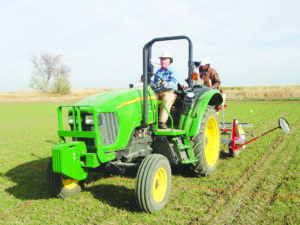Dr. Prashant Jha discusses kochi competition and control issues in sugar beet production. (Courtesy photos)
Originally published in the 6/15/18 print edition of Yellowstone County News.
HUNTLEY — Agricultural commodity prices are down. Profit margins are slim. And “research is not a free thing.”
But ag research is a key to keeping farming profitable as plant varieties and farming techniques evolve.
To help growers stay ahead, every other year, the Southern Agricultural Research Center at Huntley offers a field day to give anyone who wants to come a firsthand look at the projects underway at the 462-acre facility operated by Montana State University.
This year’s Field Day Tours are Tuesday. Everyone is welcome.
“I would hope people would want to come and see where your tax dollars are going,” said SARC superintendent Ken Kephart. “Enjoy the company of your friends and neighbors at the very least.”
Registration begins at 2:30 p.m. at SARC, which is 3.5 miles east of Huntley just off Highway 312.Tours are offered on both irrigated and dryland field trials. The first set of tours begins at 3 p.m. A free dinner of steak, burgers or brats is served by the Billings Chamber of Commerce Ag Committee from 5 to 6 p.m., followed by a second round of tours that begins at 6 p.m.
The same set of tours is offered before and after dinner. A complete schedule will be available at registration and people can choose to listen to either tour or both.
Kephart said he directs the research, but Tuesday’s speakers “have a better idea of where this is all fitting into the state.”
Tour 1 includes a discussion of research into rhizoctonia solani, a sugar beet fungal infection that can affect crowns and roots of the plant and may occur in crop rotation with corn. This is a several year study that includes Dr. Jessica Rupp of the Plant Science and Plant Pathology Department on campus in Bozeman, who will discuss the trial on Tuesday.
In the second tour, Dr. Prashant Jha will discuss weed control in Roundup Ready sugar beets, followed by his discussion of a long-term study on managing kochia.
Kephart said results of Jha’s weed control studies could affect most farmers.

Kent McVay, on the tractor, and Qasim Khan plant research trials at the Southern Agricultural Research Center in Huntley. (Courtesy photo)
For one thing, “kochia’s probably the number one weed that they deal with in sugar beets,” Kephart said.
And sugar beets and malt barley are key players in the local ag economy, he pointed out.
“Sugar beets drive the rotation,” he said. “Malt barley drives the other half. Those two entities, together, are really the impetus” of local farm production, although farmers also grow other crops like corn and alfalfa.
Pulse crops appear on the schedule in several studies, including studies of irrigated pulse varieties and water use efficiency in pulse crops, by Dr. Kent McVay. Pulse crops are legumes that can boost soil nutrient profiles. Jha will also discuss integrating winter peas or winter lentils in wheat and pulse crop rotations and soil residual herbicides for chickpeas (garbanzo beans) and lentils.
Although not a key topic of next week’s field day, Kephart said that soybeans, a crop researchers have been working on in Montana for a couple of decades, continue to show promise. Marketing them has been difficult, he said.
During his years in research, Kephart has also seen what he referred to as “fad” crops wax and wane in popularity.
“I’ve seen so many crops,” he said, “the canolas, the camolinas,” that people raise for a few years, then move on to something else.
“Soybeans stand a chance,” he said, with higher protein varieties emerging suitable for livestock feed and human consumption as culinary oil — and a preferred oil to produce biodiesel.
“We’ve established that yes, you can grow them here,” Kephart said. “Now that we have a market, people need to learn how to fit it in” to an existing crop rotation.
SARC is home to applied level research, Kephart said, designed to “answer problems of producers in this area of the state.” It’s one of seven centers in the Montana Agricultural Experiment Station Research Center System and serves a nine-county region in south-central and eastern Montana. Research is also conducted off-site, in test plots grown on farmer’s fields in several counties.
To launch new research studies, Kephart said they ask a series of questions.
“First of all, is this a researchable problem?” he said. “If it is, it’s almost always surfaced elsewhere” and they can find out what work is already underway before they begin a new study.
Next, “can we find a funding source? Research is not a free thing.”
Overall, “we try to get a handle on, what is the scope of the issue? Is it unique” to this area?
“If it turns out it’s a situation that seems to be surfacing among many farmers, it’s worth looking into.”
An advisory board made of up 22 people oversees the site. The committee is made of growers, extension agents and ag finance personnel.
Mark Helland of Miles City, who raises wheat in Rosebud County, is chairman of the SARC advisory board. He said he hopes people take advantage of the opportunity to see so much agricultural research firsthand. Researchers work hard preparing for the field days, he noted.
“The people do a great job… they put on a great display,” Helland said. The field days are a chance for people to “get a little snapshot of what they do.”
The research affects both growers and consumers “up and down that Yellowstone Valley,” he said, and is “pertinent to the crops that are there,” on both irrigated and dryland ag ground.
“As chair, I’d just like to invite people to come,” Helland said. “People who’ve never been to one will be impressed.”
With reports on a number of variety trials on the schedule, Helland said people will learn a lot on the research farm tours.
“Each researcher gives a little brief talk on what their research is about,” he said. The field days provide “a big, broad scope of what they’re doing there.”
Advisory board member Marc Vogel of North 40 Ag is urging people to take a fresh look at the SARC research, employees and results.
Vogel said he hears lingering suspicions from area growers that nothing much happens at SARC. In fact, he said he used to think that until one day he stopped in and was astonished at both the amount and the depth of research that occurred at the site.
“One of the reasons I got involved with this is I was complaining about it and I didn’t know what was going on,” Vogel said.
“There’s a disconnect between the farmers and the research being done here,” Vogel said. “We really want to get the farmers back.”
“I want to get people in the door,” he said, and help them see “a lot of opportunities for advancing some really awesome things in research.”
Some of the SARC work will pay off over time, he said.
“It’s cutting edge stuff that’s definitely going to help guys in 10 years,” he said. “We’re looking at a lot of different options” developing as far as different crops that farmers could plant.
Vogel doesn’t know for sure what it will take to bring people out the SARC field tours, but said a grower will appreciate the research done there when a problem with crop disease or insects comes up, “something that really hit their pocketbook and really resonated with them.”
Advisory board member Dave Kelsey of Molt is another tireless proponent of the experiment station.
“There’s some really important aspects of it,” Kelsey said. “I can’t emphasize the importance of ag research enough.”
Research done at SARC and in test plots on farms provide information critical to keeping farming profitable, fight disease and find ways to use resources more efficiently, he said.
“I host a test plot out here on my farm at Molt,” he said, and has for several years. “It is so critical for us to get that local information and see what the varieties will do” under different conditions.
Although the two communities are relatively close, Molt’s growing conditions are actually quite different from conditions at Huntley, Kelsey noted, so test plots at his place help provide more details about how different conditions may affect a crop.
Some of the research done at SARC and other experiment stations led to the development of crops like Roundup Ready sugar beets, alfalfa and corn — bred to resist glyphosate, the active ingredient in the herbicide Roundup.
Using Roundup decreased the amount of other herbicides used in those crops, and Kelsey pointed out that increased yields and decreased costs.
With GMO or genetically modified crops, Kelsey said, “people don’t like it, but those things are big improvements,” especially as farmers are called on to provide more food for a growing population.
“It is critical to maintain some improvement” of productivity, Kelsey said. It can make the difference between staying in business or selling the farm.
Some growers have a hard time getting to field days, and Kelsey said he knows people in production agriculture are busy.
“Time is limited,” he said, “but at the same time, it makes the research that much more important to you.”
Vogel said he is taking a personal interest in motivating people to attend the field days.
“I was going to get on the horn and call some people here and let them know that they’re expected to be there,” he said. “We’ll keep chipping away at it.”
Vogel figures if he can transition from critic to advocate, other growers can, too.
“I’ve been probably the squeakiest wheel” on the advisory board, he said, since he sees field days as the quintessential marketing tool.
“You’ve got to figure out how to show the consumer, AKA the farmer,” what is being accomplished at SARC, Vogel said. “They don’t see the value in the experiment farm… people say, ‘What are they even doing there?'”
Come on Tuesday, he said, eat a free steak and see what they are doing there.


